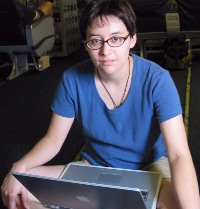Student Researcher Awarded First Suomi-Simpson Fellowship
 Madison, WI, August 20, 2002—Shaima Nasiri, a graduate student pursuing a doctoral-level degree in UW–Madison’sDepartment of Atmospheric and Oceanic Sciences, has received the first Suomi-Simpson Graduate Fellowship, sponsored by UW–Madison and NASA.
Madison, WI, August 20, 2002—Shaima Nasiri, a graduate student pursuing a doctoral-level degree in UW–Madison’sDepartment of Atmospheric and Oceanic Sciences, has received the first Suomi-Simpson Graduate Fellowship, sponsored by UW–Madison and NASA.
The grant is named for the late Verner E. Suomi, founding director of the University of Wisconsin–Madison’s Space Science and Engineering Center and emeritus professor in the Department of Meteorology and for Joanne Simpson, Chief Scientist for Meteorology in the Goddard Space Flight Center’s Earth Sciences Directorate. The two meteorological giants maintained a career-long collaboration, Simpson said, starting with the instrument course she took from Suomi in 1946.
According to Nasiri, “This fellowship creates a direct line between me and scientists at Goddard Space Flight Center.” She will work with scientists in Goddard’s Earth Observing System program, primarily Michael King, NASA’s EOS senior project scientist, and scientist Steven Platnick. Besides enhancing collaboration, the fellowship will enable travel to and from Wisconsin and Goddard, near Washington, D.C., as well as field experiment sites. Nasiri took part in the Florida-based CRYSTAL-FACE field campaign, where scientists studied the role of clouds, particularly cirrus, in climate.
Steven Ackerman, UW–Madison atmospheric science professor who also directs the Cooperative Institute for Meteorological Satellite Studies, advises Shaima Nasiri in her doctoral studies. He said, “Shaima is an excellent choice for this fellowship that encourages the type of collaborations undertaken by Drs. Suomi and Simpson. She approaches her research with enthusiasm and vigor and has worked collaboratively with scientists from Goddard as well as scientists from other NASA institutes.”
For her research toward her atmospheric science Ph.D., Nasiri studies overlapping clouds, phenomena difficult to discern in satellite data in any conventional way. She hopes to improve retrievals of cloud properties which are used to create cloud climatologies. She explained that “current satellite retrieval schemes assume one layer of cloud.” Nasiri seeks a solution that will work globally. She also wants to help increase the usefulness of the MODIS instrument on board NASA’s earth observing satellites used to provide information about global cloud cover to improve climate models. This will help her collaborators at Goddard, where the Earth Observing System is being used to study climate change issues.
Nasiri received a MS degree from UW-Madison’s Atmospheric and Oceanic Sciences department in 1999. Her thesis focused on discriminating between clouds and snow in sounder data from the GOES weather satellite, wryly noting, “that’s another instrument not designed for the purpose.” She explained that “the problem wasn’t intractable because the snow-covered regions that were problematic for the sounder were the same ones that could be detected.” She notes that “the key thing is understanding the problem.”
After she graduated, CIMSS employed her to make cloud property retrievals from MODIS data, research unrelated to her current work. She also performed as part of the team supporting SSEC’s Scanning-High-resolution Interferometer Sounder in field experiments. She has co-authored more than a dozen scientific publications, including five peer-reviewed papers.
Shaima Nasiri grew up in San Diego, California, where her family still lives. As an undergraduate at the University of Denver, she majored in Physics and Mathematics. Nasiri is aiming at early 2004 to finish her Ph.D. Her outside interests include cooking, soccer and long walks in the park.
For past features and columns, see SSEC’s News page.
